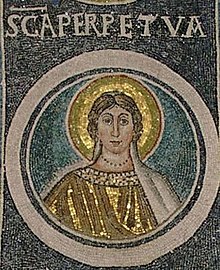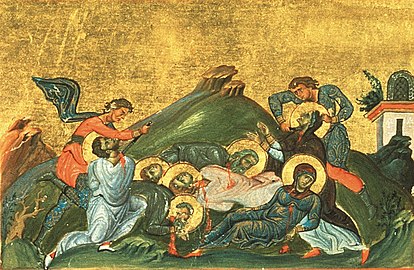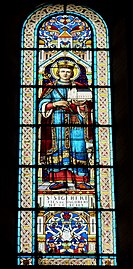February 1 (Eastern Orthodox liturgics)
January 31 - Eastern Orthodox liturgical calendar - February 2
All fixed commemorations below are observed on February 14 by Eastern Orthodox Churches on the Old Calendar.[note 1]
For February 1, Orthodox Churches on the Old Calendar commemorate the Saints listed on January 19.
Feasts[]
- Forefeast of the Meeting of our Lord in the Temple.[1][2][3]
Saints[]
- Martyr Tryphon of Campsada near Apamea in Syria (250)[1][4]
- Martyr Theonas, with Two Children.[5]
- Martyr Karion.[6]
- Venerable Peter of Galatia, hermit near Antioch in Syria (429)[1][7][8][note 2] (see also: November 25)
- Venerable Vendemanius (Bendemanius), hermit of Bithynia (512)[1][9]
- Saint Anthony the Hermit, in Georgia (6th century)[10]
- Great-martyr Elijah of Heliopolis, (Elias the New, of Damascus) (779)[1][11]
- Saints David (784), Symeon (843), and George (844), Confessors of Mytilene.[1][12]
- Saint Basil I the Confessor, Archbishop of Thessalonica (862)[13]
- Saint Basil II the Synaxaristis, Archbishop of Thessalonica (c. 904)[1][14]
- Saint Timothy the Confessor.[15]
Pre-Schism Western saints[]
- Martyrs Perpetua of Carthage, and the catechumens Satyrus, Revocatus, Saturninus, Secundus, and Felicity, at Carthage (202-203)[1][16][note 3] (see also: March 7 - West)
- Saint Severus, Bishop of Ravenna, attended the Council of Sardica in 344 (348)[18][19][note 4]
- Saint Paul of Trois-Châteaux, Bishop of Trois-Châteaux in the Dauphiné (c. 405)[18][note 5]
- Venerable Brigid of Kildare (524)[1][21][22][23][24][note 6]
- Saint Darlugdach of Kildare (Derlugdacha), successor of St Brigid as second Abbess of Kildare in Ireland (c. 524)[18][25][26]
- Saint Ursus of Aosta, born in Ireland, he preached against Arianism in the south of France and later went to Aosta in Italy (6th century)[18]
- Saint Seiriol, Abbot of Penmon Priory, Anglesey (6th century)[1] (see also: January 2)
- Saint Sigebert III, King of Austrasia (656)[18][27]
- Saint Severus of Avranches, Abbot and Bishop of Avranches (c. 690)[18][28]
- Saint Brigid the Younger, sister of St Andrew the Scot, Abbot of St. Donatus in Fiesole in Tuscany in Italy (9th century)[18][29]
- Saint Clarus of Seligenstadt, ascetic and hermit (c. 1048)[18]
Post-Schism Orthodox saints[]
- Saint Tryphon, Bishop of Rostov (1468)[1][30]
- New Martyr Anastasius of Nauplion (1655)[1][31][32]
- The Four Martyrs of Megara: Polyeuctos, George, Adrianos and Platon, the "Newly-Revealed" (1754, 1998)[33][34][note 7]
New martyrs and confessors[]
- New Martyr Anastasios of Nauplion (1655)[1][35]
- New Hieromartyr Peter Skipetrov, Archpriest, of Petrograd (1918)[36][37] (see also: January 19)
- New Hieromartyr Nicholas Mezentsev, Archpriest, of Simferopol (1938)[1][36][38][39]
Other commemorations[]
Icon gallery[]

Meeting of the Lord. Russian Orthodox icon, 15th century

Martyr Tryphon of Campsada.

Martyr Tryphon of Campsada (Menologion of Basil II, 10th century).

Venerable Vendemanius, hermit of Bithynia (Menologion of Basil II, 10th century).

St. Perpetua of Carthage, mosaic, c. 1280.

Sts. Martyrs Perpetua of Carthage, and catechumens Saturus, Revocatus, Saturninus, Secundulus, and Felicitas at Carthage (Menologion of Basil II, (c. 985)).

St Brigit of Kildare, stained glass.

St. Ursus of Aosta.
St. Sigebert III, stained glass window.
Notes[]
- ^ The notation Old Style or (OS) is sometimes used to indicate a date in the Julian Calendar (which is used by churches on the "Old Calendar".
The notation New Style or (NS), indicates a date in the Revised Julian calendar (which is used by churches on the "New Calendar"). - ^ This St. Peter should not be confused with the other St. Peter of Galatia (9th century), who is commemorated on October 9.
- ^ "O GOD, who among the manifold works of thine almighty power hast bestowed even upon the weakness of women strength to win the victory of martyrdom: grant, we beseech thee, that we, who on this day recall the heavenly birth of blessed Perpetua and Felicity, thy Martyrs, may so follow in their footsteps, that we may likewise attain unto thee. Through Christ our Lord. Amen."[17]
- ^ "At Ravenna, the holy bishop Severus, whose great virtues deserved that he should be raised to the episcopate by the sign of a dove."[20]
- ^ "At Trois-Chateaux, in France, St. Paul, bishop, whose life was eminent for virtues, and whose death was made precious by miracles."[20]
- ^ "In Ireland, St. Bridget, virgin. One day, at her touch, the wood of an altar immediately sprouted into life, in testimony of her virginity."[20]
- ^ The year and manner of martyrdom of the Holy Martyrs Adrianos, Polyeuctos, Platon, and George are unknown. But we do know the wondrous manner in which the relics of these holy martyrs were found by the grace of God in Megara. In the year 1754, a cleric named Oikonomos (which could have something to do with being "Oikonomos" of the Patriarch of Jerusalem) wanted to build a house. When the workers of the community were digging and constructing the foundations, one of them claimed that he felt an intense heat at his feet, and indicated that he couldn't keep working. The Oikonomos put his hands in the spot, and paradoxically felt the same heat as the worker. The rest of the workers, however, kept digging until they hit a marble slab with the following inscription on it:
- (in Greek) "Λείψανα Μαρτύρων. Αδριανός, Πολύευκτος, Πλάτων, Γεώργιος" - [The relics of the Martyrs Adrianos, Polyeuctos, Platon, George].
- (in Greek) "Λείψανα Μαρτύρων. Αδριανός, Πολύευκτος, Πλάτων, Γεώργιος" - [The relics of the Martyrs Adrianos, Polyeuctos, Platon, George].
- ^ Austrian soldiers occupied the district of Moldavia during the Crimean War, causing great hardship for its inhabitants. The Sokolsky Monastery, a center of spiritual life for a hundred years, was suppressed and its monks were scattered. The seminary along with the Sokolsky Icon moved to another location.
References[]
- ^ Jump up to: a b c d e f g h i j k l m n February 1/14. Orthodox Calendar (pravoslavie.ru).
- ^ Great Synaxaristes: (in Greek) Προεόρτια τῆς Ὑπαπαντῆς τοῦ Κυρίου ἡμῶν Ἰησοῦ Χριστοῦ. 1 Φεβρουαρίου. Μεγασ Συναξαριστησ.
- ^ Forefeast of the Meeting of our Lord in the Temple. OCA - Feasts and Saints.
- ^ Great Synaxaristes: (in Greek) Ὁ Ἅγιος Τρύφων ὁ Μάρτυρας. 1 Φεβρουαρίου. Μεγασ Συναξαριστησ.
- ^ Great Synaxaristes: (in Greek) Ὁ Ἅγιος Θεΐων μετὰ τῶν δύο παίδων. 1 Φεβρουαρίου. Μεγασ Συναξαριστησ.
- ^ Great Synaxaristes: (in Greek) Ὁ Ἅγιος Καρίων ὁ Μάρτυρας. 1 Φεβρουαρίου. Μεγασ Συναξαριστησ.
- ^ Great Synaxaristes: (in Greek) Ὁ Ὅσιος Πέτρος ὁ ἐν Γαλατίᾳ . 1 Φεβρουαρίου. Μεγασ Συναξαριστησ.
- ^ Venerable Peter the Hermit of Galatia Near Antioch, in Syria. OCA - Feasts and Saints.
- ^ Great Synaxaristes: (in Greek) Ὁ Ὅσιος Βενδιμιανός. 1 Φεβρουαρίου. Μεγασ Συναξαριστησ.
- ^ Great Synaxaristes: (in Greek) Ὁ Ὅσιος Ἀντώνιος ὁ Ἐρημίτης. 1 Φεβρουαρίου. Μεγασ Συναξαριστησ.
- ^ Great Synaxaristes: (in Greek) Ὁ Ἅγιος Ἠλίας ὁ Μεγαλομάρτυρας. Φεβρουαρίου. Μεγασ ΣυναξαριστησΣ.
- ^ Great Synaxaristes: (in Greek) Οἱ Ὅσιοι Δαβίδ, Συμεὼν καὶ Γεώργιος οἱ αὐτάδελφοι ἐκ Μυτιλήνης. 1 Φεβρουαρίου. Μεγασ Συναξαριστησ.
- ^ Great Synaxaristes: (in Greek) Ὁ Ἅγιος Βασίλειος ὁ Ὁμολογητής Ἀρχιεπίσκοπος Θεσσαλονίκης. 1 Φεβρουαρίου. Μεγασ Συναξαριστησ.
- ^ Great Synaxaristes: (in Greek) Ὁ Ἅγιος Βασίλειος ὁ Συναξαριστὴς Ἀρχιεπίσκοπος Θεσσαλονίκης. 1 Φεβρουαρίου. Μεγασ Συναξαριστησ.
- ^ Great Synaxaristes: (in Greek) Ὁ Ὅσιος Τιμόθεος. 1 Φεβρουαρίου. Μεγασ Συναξαριστησ.
- ^ Great Synaxaristes: (in Greek) Ἡ Ἁγία Περπέτουα ἡ Μάρτυς καὶ οἱ σὺν αὐτῇ. 1 Φεβρουαρίου. Μεγασ Συναξαριστησ.
- ^ "March 6th: SS. Perpetua and Felicity, MM." In: The Anglican Breviary, Containing The Divine Office According To The General Usages Of The Western Church. Frank Gavin Liturgical Foundation, Inc., New York, 1955. pp. 1128-1129.
- ^ Jump up to: a b c d e f g h February 1. Latin Saints of the Orthodox Patriarchate of Rome.
- ^ Rev. Sabine Baring-Gould (M.A.). "S. Severus, B. C., of Ravenna. (About A.D. 390.)." In: The Lives of the Saints. Volume the Second: February. London: John C. Nimmo, 1897. pp. 12-14.
- ^ Jump up to: a b c The Roman Martyrology. Transl. by the Archbishop of Baltimore. Last Edition, According to the Copy Printed at Rome in 1914. Revised Edition, with the Imprimatur of His Eminence Cardinal Gibbons. Baltimore: John Murphy Company, 1916. pp. 34–35.
- ^ Great Synaxaristes: (in Greek) Ἡ Ὁσία Μπριντζίτα. 1 Φεβρουαρίου. Μεγασ Συναξαριστησ.
- ^ Venerable Brigid (Bridget) of Ireland. OCA - Feasts and Saints.
- ^ Very Rev. John O'Hanlon. "Article I. — Life of St. Brigid, Virgin, First Abbess of Kildare, Special Patroness of Kildare Diocese, and General Patroness of Ireland. [Fifth and Sixth Centuries]." In: Lives of the Irish Saints: With Special Festivals, and the Commemorations of Holy Persons. Vol. II. Dublin, 1875. pp. 1-224.
- ^ Rev. Sabine Baring-Gould (M.A.). "S. Bridget, V. Abss. (A.D. 525.)." In: The Lives of the Saints. Volume the Second: February. London: John C. Nimmo, 1897. pp. 14-22.
- ^ Very Rev. John O'Hanlon. "Article II.—St. Derlugdacha, Virgin, and Second Abbess of Kildare. [Fifth and Sixth Centuries]." In: Lives of the Irish Saints: With Special Festivals, and the Commemorations of Holy Persons. Vol. II. Dublin, 1875. pp. 225-228.
- ^ Rev. Sabine Baring-Gould (M.A.). "S. Darlugdach, V. (A.D. 526.)." In: The Lives of the Saints. Volume the Second: February. London: John C. Nimmo, 1897. pp. 22-23.
- ^ Rev. Sabine Baring-Gould (M.A.). "S. Sigebert, K. C. (A.D. 656.)." In: The Lives of the Saints. Volume the Second: February. London: John C. Nimmo, 1897. pp. 24-25.
- ^ Rev. Sabine Baring-Gould (M.A.). "S. Severus, B. of Avranches. (6th cent." In: The Lives of the Saints. Volume the Second: February. London: John C. Nimmo, 1897. pp. 23-24.
- ^ Very Rev. John O'Hanlon. "Article IV.—Saint Brigid, Virgin, Patroness of the Church of Opacum, at Fiesole, Italy. [Ninth Century]." In: Lives of the Irish Saints: With Special Festivals, and the Commemorations of Holy Persons. Vol. II. Dublin, 1875. pp. 234-238.
- ^ St Tryphon, Bishop of Rostov. OCA - Feasts and Saints.
- ^ Great Synaxaristes: (in Greek) Ὁ Ἅγιος Ἀναστάσιος ὁ Νεομάρτυρας ὁ Ναυπλιώτης. 1 Φεβρουαρίου. Μεγασ Συναξαριστησ.
- ^ St. Nectarios Press. "New Martyr Anastasios of Navplion." In: New Martyrs of the Turkish Yoke. Seattle, Washington, 1985. pp.43-44.
- ^ Great Synaxaristes: (in Greek) Οἱ Ἅγιοι Ἀδριανός, Πολύευκτος, Πλάτων καὶ Γεώργιος οἱ Μάρτυρες ἐν Μεγάροις. 1 Φεβρουαρίου. Μεγασ Συναξαριστησ.
- ^ Jump up to: a b Mystagogy: The Weblog of John Sanidopoulos. The Newly-Revealed Four Martyrs of Megara. February 1, 2010.
- ^ Leonidas J. Papadopulos, Georgia Lizardos, et al (Transl.). "The Miracle of Saint John Baptist in Chios." In: New Martyrs of the Turkish Yoke. Seattle: St. Nectarios Press, 1985. pp. 43-44.
- ^ Jump up to: a b February 14 / February 1. Holy Trinity Russian Orthodox Church (A Parish of the Patriarchate of Moscow).
- ^ Great Synaxaristes: (in Greek) Ὁ Ἅγιος Πέτρος ὁ Ἱερομάρτυρας. 1 Φεβρουαρίου. Μεγασ Συναξαριστησ.
- ^ (in Russian) 1 февраля (ст.ст.) 14 февраля 2013 (нов. ст.). Русская Православная Церковь Отдел внешних церковных связей. (DECR).
- ^ (in Russian) 1 февраля по старому стилю / 14 февраля по новому стилю. Русская Православная Церковь - Православный церковный календарь на 2018 год.
- ^ Icon of the Mother of God "Sokolsky". OCA - Feasts and Saints.
- ^ The appearance of the "Weeping" Icon of the Mother of God in Romania Archived 2015-10-24 at the Wayback Machine. Russian Cathedral of St. John the Baptist, Washington, D.C.
Sources[]
- February 1/14. Orthodox Calendar (pravoslavie.ru).
- February 14 / February 1. Holy Trinity Russian Orthodox CHurch (A Parish of the Patriarchate of Moscow).
- February 1. OCA - The Lives of the Saints.
- February 1. Latin Saints of the Orthodox Patriarchate of Rome.
- The Roman Martyrology. Transl. by the Archbishop of Baltimore. Last Edition, According to the Copy Printed at Rome in 1914. Revised Edition, with the Imprimatur of His Eminence Cardinal Gibbons. Baltimore: John Murphy Company, 1916. pp. 34–35.
- Rev. Richard Stanton. A Menology of England and Wales, or, Brief Memorials of the Ancient British and English Saints Arranged According to the Calendar, Together with the Martyrs of the 16th and 17th Centuries. London: Burns & Oates, 1892. pp. 44–46.
Greek Sources
- Great Synaxaristes: (in Greek) 1 Φεβρουαριου. Μεγασ Συναξαριστησ.
- (in Greek) Συναξαριστής. 1 Φεβρουαρίου. Ecclesia.gr. (H Εκκλησια τησ Ελλαδοσ).
Russian Sources
- (in Russian) 14 февраля (1 февраля). Православная Энциклопедия под редакцией Патриарха Московского и всея Руси Кирилла (электронная версия). (Orthodox Encyclopedia - Pravenc.ru).
- (in Russian) 1 февраля (ст.ст.) 14 февраля 2013 (нов. ст.). Русская Православная Церковь Отдел внешних церковных связей. (Decr).
- (in Russian) 1 февраля по старому стилю / 14 февраля по новому стилю. Русская Православная Церковь - Православный церковный календарь на 2018 год.
- February in the Eastern Orthodox calendar











